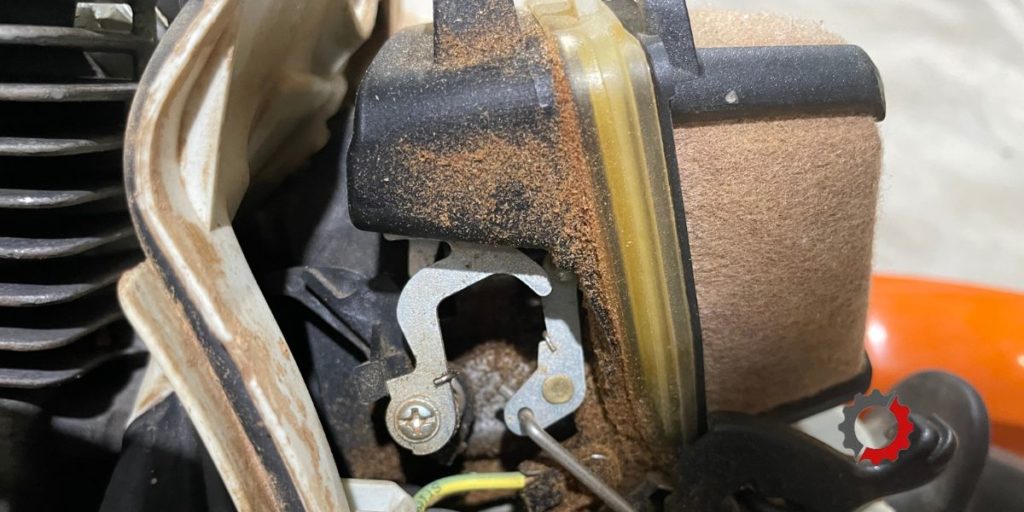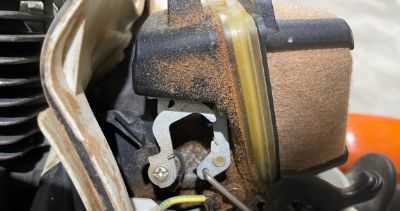A chainsaw that starts and only runs with the choke on to restrict airflow is usually an issue that can be easily fixed. It’s best to find and fix the problem right away before it develops into a bigger more costly problem.
A Stihl chainsaw only runs with the choke on when it is getting too much air or not enough fuel. The choke must be on to restrict the amount of airflow to provide the engine with the fuel-to-air mixture it requires to run.
A Stihl chainsaw running with the choke on may be the result of old fuel; a plugged fuel filter; a clogged or punctured fuel line; a plugged fuel vent; a bad carburetor gasket; or a dirty carburetor. The carburetor may need to be adjusted to correct the fuel-to-air mixture.
Before making any repairs, shut off your chainsaw, wait for all moving parts to stop, and wait for the engine to cool. Follow all safety guidelines found in your Stihl operators manual.

This post may include affiliate links. Purchases made through these links may provide a commission for us, at no extra cost to you. As an Amazon Associate, we earn from qualifying purchases.
Follow all safety instructions provided in your equipment operator’s manual prior to diagnosing, repairing, or operating.Consult a professional if you don’t have the skills, or knowledge or are not in the condition to perform the repair safely.
7 Reasons a Stihl Chainsaw Only Runs With the Choke On
Old Gas in a Stihl Chainsaw
Old gas is one of the main culprits causing fuel restrictions. When a Stihl chainsaw doesn’t get enough fuel, the choke will restrict airflow so the engine is getting the ratio of gas to air it requires to keep running.
Old gas sitting in a Stihl chainsaw can develop sticky substances and a varnish that clogs fuel components and prevents a sufficient flow of fuel.
When you find you have gas that’s been sitting in your saw for a long period of time, it’s best to drain the tank and refill it with a fresh gas and oil fuel mix. Add a fuel stabilizer like Sea Foam or STA-BIL to the fuel to assist with cleaning out the fuel system and reducing moisture.
Once you refill the tank with fresh fuel and a stabilizer, start and run your chainsaw for several minutes to work the treated fuel through the chainsaw.
Reduce the negative effects of fuel by following these tips:
- Use gasoline with a minimum octane rating of 89.
- Don’t use gasoline with an ethanol content greater than 10%. Low ethanol or non-ethanol fuel is best.
- Mix the gasoline with a premium 2-cycle oil at a ratio of 50:1 for Stihl 2-cycle chainsaws.
- Store fuel in a dry location.
- Consume the fuel within 30 days before it begins to break down or add a fuel stabilizer to make it last a little longer.
- Stihl recommends consuming the fuel within 30 days and no longer than 60 days.
To learn more about the right fuel to use, check out “This is the Type of Gas and Oil Stihl Chainsaws Use“.
Plugged Fuel Filter in a Stihl Chainsaw
The fuel filter is a fuel component that can become plugged and prevent a good flow of fuel to enter the fuel line. The fuel filter’s function is to keep dirt and other contaminates out of the fuel system.
When it isn’t changed out regularly, dirt will build up on the filter and restrict the amount of fuel allowed to flow through the filter. The fuel filter is a cylinder-shaped component attached to the fuel line located inside the fuel tank.
To reach the filter to change it out, begin by wiping around the fuel tank cap with a clean cloth to keep dirt and sawdust from falling into the fuel tank. Pull the fuel filter out of the tank using a clean bent wire.
Use needle nose pliers to hold the fuel line while pulling the filter out of the line. Be careful not to drop the fuel hose into the fuel tank. Insert the new fuel filter.
Once the new fuel filter is securely attached to the end of the fuel line, place it back inside the fuel tank. Reinstall the fuel tank cap.
Punctured or Clogged Fuel Line on a Stihl Chainsaw
The choke may need to be on when the fuel line is clogged preventing a good flow of fuel. It may also be due to air being introduced to the fuel system through a puncture in the fuel line.
When the fuel line is clogged, the clog must be removed. To do this, remove the fuel line from the chainsaw. Spray carburetor cleaner into the line to loosen the clog. Follow by blowing compressed air into the line to remove the clog.
Reinstall the line once the blockage has been removed. If you can’t remove the blockage or you find the fuel line is dry and cracked, you should replace it with a new one.
Look for a puncture in the line where air can be sucked into the fuel system providing additional air to the cylinder and making the choke necessary to correct the amount of air. Replace the line.
Plugged Fuel Vent on a Stihl Chainsaw
There is a small circular vent on a Stihl chainsaw. This vent is needed to allow air to pass through it so the atmospheric pressure stays equal to the fuel tank pressure.
When the fuel tank is unable to vent properly, the tank will build pressure forming a vacuum that will restrict fuel flowing out of the tank. This will reduce the amount of fuel supplied to the carburetor.
To test whether you have a clogged fuel tank vent, use a vacuum tester. If you don’t have a vacuum tester, you can place your saw on a level surface, start it, and remove the choke.
If it begins to run sluggishly, remove or loosen the fuel cap to allow air into the tank.
When air is able to pass into the tank, the engine should run fine. This is a good indication you may have a problem with the fuel tank vent.
Reinstall and tighten the fuel cap while allowing the saw to continue to run to try to replicate the issue where the engine begins to run sluggish and possibly shut off after using it for several minutes.
Replace a plugged Stihl fuel tank vent.
Bad Carburetor Gasket on a Stihl Chainsaw
The carburetor gasket, located behind the carburetor, can deteriorate allowing air into the system because the gasket no longer seals correctly. This will cause your Stihl chainsaw to run lean when there is more air than fuel in the cylinder than it requires to run.
Access the carburetor and carefully remove the linkages and bolts attached to the carburetor. Remove the carburetor and gasket. Install a new carburetor gasket.
Before you install the carburetor, check it out. You may need to clean it while you have it off the chainsaw.
Dirty Carburetor on a Stihl Chainsaw
The carburetor’s function is to regulate the amount of fuel that is mixed with air to form a combustion to start and run your Stihl chainsaw. A buildup of varnish and deposits can make the carburetor not correctly perform this function.
If you are a little mechanical you should be able to handle cleaning your carburetor. Clean the carburetor by taking it apart and using carburetor cleaner to remove deposits left behind from old fuel.
If the carburetor does not function after being cleaned, you may need to rebuild it or replace it with a new carburetor.
Carburetor Needs Adjustment on a Stihl Chainsaw
The carburetor may need to be adjusted to change the RPMs at idle speed and at full throttle. It may be causing the engine to run lean resulting in the need for the choke to be on.
There are adjustment screws on the carburetor to make these adjustments. You can find these screws on the righthand side of the chainsaw near the pull starter.
The screws are labeled “L” for low speed “LA” for idle speed and “H” for high speed. Start and let the chainsaw warm up for a few minutes before making adjustments to the carburetor.
Begin adjusting your Stihl chainsaw carburetor by setting the carburetor to its standard setting:
Begin the carburetor adjustment by placing the “H” and “L” adjustment screws at their original standard settings. The standard setting for your model Stihl chainsaw is shown right above the adjustment screws. This setting varies by model.
- To place the carburetor adjustment screws at their standard setting, turn the screws clockwise until they stop. Then turn each screw counter-clockwise with the number of turns indicated above the screw.
- For example, in the photo below, the H screw is turned counter-clockwise 3/4 of a turn. The L screw is turned counter-clockwise one full turn. Again, this may be different for your model Stihl saw.

Once the carburetor is set to its standard setting, fine-tune the settings:
- Adjust “L” low-speed screw: Start the saw and let the chainsaw idle. Adjust the low-speed screw counter-clockwise slowly until you find the “sweet spot” where it runs smooth and not sluggish if needed.
- Adjust “LA” idle screw: Next, while the chainsaw is idle, make sure the chain is not moving. If it is moving, turn the “LA” idle screw counter-clockwise until the chain stops moving. Then continue to turn it counter-clockwise 1/4 turn further.
If your saw dies at idle, turn the idle screw clockwise until the chain just starts to move. Then turn the screw counter-clockwise 1/4 turn.
- Adjust “H” high-speed screw: Next, fine-tune the “H” screw to get a good smooth RPM at full throttle by slowly turning the adjustment screw clockwise if needed. Don’t over-adjust and allow the RPMs to increase too much or you will damage the engine.
Stihl does have some limits to the adjustments you can perform to the carburetor. If you are continuing to have problems with the carburetor, bring your chainsaw to your local Stihl dealer.
